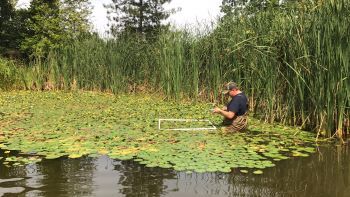|
June 5, 2024
Contact: Billy Keiper, 517-342-4087 or Joanne Foreman, 517-284-5814
Preventing new invasive species from entering Michigan is the first goal in Michigan’s aquatic invasive species management plan, but prevention efforts are not perfect, and some invaders still make it into the state. Finding new invasions early improves chances of slowing their spread or possibly eradicating the population.
The state’s aquatic invasive species program has resources in place to respond to new detections of high-priority invasive species, but the program staff needs your help spotting and reporting the invasive plants and animals on Michigan’s watch list.
Michigan’s watch list
Invasive species on Michigan’s watch list have been identified as posing an immediate or potential threat to Michigan's economy, environment or human health. These species either have never been confirmed in the wild in Michigan or have a limited known distribution. There currently are 33 species on the watch list. The 18 aquatic species include:

- 10 aquatic plants.
- Five fish.
- Two crayfish.
- The New Zealand mudsnail.
Seven of the 10 aquatic plants on the watch list, including yellow floating heart, water lettuce, parrot feather and hydrilla, have been detected in limited areas in Michigan. Some were found by state or cooperative invasive species management area staff, while others were reported by lake management companies or members of the public.
Information on watch list species, including photos and illustrations to help identify their characteristics, can be found on the watch list webpage.
|
Early detection and response to aquatic plants
The state’s aquatic invasive plant early detection and response team has been active since 2011, with support from the Great Lakes Restoration Initiative. The team conducts investigations and responds to confirmed detections of watch list aquatic plants by assessing the risk posed by the invading plant, reviewing response options and, if feasible, planning and implementing a response.
Responses are tailored to the situation. Large infestations or those that occur in multiple waterbodies may require partners like CISMAs, volunteers and contracted pesticide applicators working together over time to manage the situation. Smaller discoveries such as those found in private ponds may provide the opportunity to fully eradicate the plant from the area.
Response actions often take several years to complete, requiring one to two years of treatment plus three years of post-treatment monitoring to ensure regrowth of the target species doesn’t occur. To date, seven populations of watch list plants have been eradicated and several additional locations are nearing the eradication milestone.
Hydrilla in Michigan

Michigan’s first detection of hydrilla in 2023 is a prime example of the process in action. Hydrilla, considered the world's most invasive aquatic plant, was confirmed by EGLE staff in two small, adjacent private ponds on residential properties near Berrien Springs in Berrien County.
Plants were discovered during routine monitoring following treatment for another invasive plant, parrot feather, which was found in the ponds in 2020. EGLE’s immediate actions included surveying connected ponds, a receiving stream and the St. Joseph River to ensure the full extent of the hydrilla population was known. Herbicide was applied shortly after the discovery to prevent the plant’s spread to other bodies of water, with the long-term goal of eradication.
|
You can help
While you’re enjoying Michigan’s lakes, rivers and streams this summer, keep an eye out for aquatic plants on Michigan’s watch list. If you see one, take photos and note the location, then report it as soon as possible.
Please report any suspicious aquatic plants to the Michigan Department of Environment, Great Lakes, and Energy’s Aquatic Invasive Species Program at EGLE-WRD-AIP@Michigan.gov or through the Midwest Invasive Species Information Network’s website or smartphone app, found at MISIN.MSU.edu.
Also remember to “Clean, Drain and Dry” your watercraft, trailer and recreational gear before heading to a new location. Your help will go a long way toward preventing the spread of harmful aquatic plants.
Michigan's Invasive Species Program is cooperatively implemented by the Michigan departments of Agriculture and Rural Development; Environment, Great Lakes, and Energy; and Natural Resources.
Note to editors: Accompanying photos are available below for download. Caption information follows.
WL wheel: There are 10 aquatic plants on Michigan's invasive species watch list.
EFB survey: An EGLE biologist surveys for aquatic invasive plants.
|